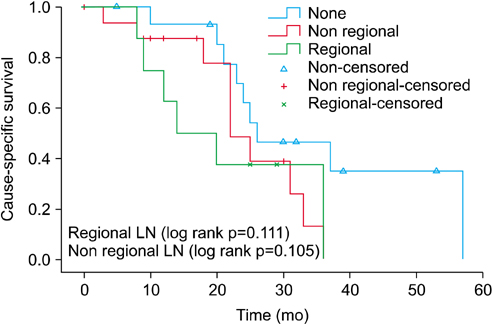Korean J Urol.
2012 Oct;53(10):673-679. 10.4111/kju.2012.53.10.673.
Influence of Nonregional Lymph Node Metastasis as a Prognostic Factor in Metastatic Prostate Cancer Patients
- Affiliations
-
- 1Department of Urology, Korea University Anam Hospital, Seoul, Korea. jcheon@korea.ac.kr
- KMID: 1856985
- DOI: http://doi.org/10.4111/kju.2012.53.10.673
Abstract
- PURPOSE
In advanced prostate cancer, malignant cells generally tend to spread into the bone, and metastasis into nonregional lymph nodes (NRLNs) at the time of initial diagnosis is relatively rare. We investigated the prognostic significance of NRLN metastasis in patients receiving hormonal therapy and chemotherapy.
MATERIALS AND METHODS
From February 2005 to August 2011, we identified 105 patients who had metastatic prostate cancer. First, we assessed the prognostic effect of NRLN metastasis on the prostate-specific antigen response through logistic regression and the progression-free time to castration-resistant prostate cancer (CRPC) by using the Cox proportional hazard regression model. Second, we investigated the prognostic influence of NRLN metastasis on the chemotherapy response through logistic regression and on cancer-specific survival of CRPC patients receiving chemotherapy by using Cox proportional analysis.
RESULTS
Of these 105 patients, 12 patients (11.4%) had only NRLN metastases without bone metastases. Progression-free time to CRPC was significantly less in patients with NRLN metastases by Cox proportional hazard regression multivariate analysis (p=0.020). However, NRLN metastasis was not an independent factor for predicting the response to chemotherapy in CRPC patients, and NRLN metastasis did not reduce cancer-specific survival in the multivariate analysis.
CONCLUSIONS
Twelve (11.4%) of 105 patients with NRLN metastases had lymph node metastases without bone metastases. In addition, NRLN metastasis was a significant prognostic factor for predicting reduced progression-free time to CRPC. Thus, although we speculate that prostate cancer with NRLN metastasis exhibits unique tumor biology, additional molecular and genetic studies are needed.
Keyword
MeSH Terms
Figure
Reference
-
1. McCullough DL, Prout GR Jr, Daly JJ. Carcinoma of the prostate and lymphatic metastases. J Urol. 1974. 111:65–71.2. Park SK, Sakoda LC, Kang D, Chokkalingam AP, Lee E, Shin HR, et al. Rising prostate cancer rates in South Korea. Prostate. 2006. 66:1285–1291.3. Galasko CS. Skeletal metastases. Clin Orthop Relat Res. 1986. (210):18–30.4. Logothetis CJ, Navone NM, Lin SH. Understanding the biology of bone metastases: key to the effective treatment of prostate cancer. Clin Cancer Res. 2008. 14:1599–1602.5. Albertsen PC, Hanley JA, Fine J. 20-year outcomes following conservative management of clinically localized prostate cancer. JAMA. 2005. 293:2095–2101.6. Johansson JE, Andren O, Andersson SO, Dickman PW, Holmberg L, Magnuson A, et al. Natural history of early, localized prostate cancer. JAMA. 2004. 291:2713–2719.7. Epstein JI. Wein AJ, Kavoussi LR, Novick AC, Partin AW, Peters CA, editors. Pathology of prostatic neoplasia. Campbell's urology. 2012. 10th ed. Philadelphia: Saunders;2726–2734.8. Corriere JN Jr, Cornog JL, Murphy JJ. Prognosis in patients with carcinoma of the prostate. Cancer. 1970. 25:911–918.9. Furuya Y, Akakura K, Akimoto S, Ito H. Prognosis of patients with prostate carcinoma presenting as nonregional lymph node metastases. Urol Int. 1998. 61:17–21.10. Gleason DF, Mellinger GT. Prediction of prognosis for prostatic adenocarcinoma by combined histological grading and clinical staging. J Urol. 1974. 111:58–64.11. Harmer MH. TNM classification of malignant tumours. 1978. 3rd ed. Geneva: International Union against Cancer.12. Soloway MS, Hardeman SW, Hickey D, Raymond J, Todd B, Soloway S, et al. Stratification of patients with metastatic prostate cancer based on EOD on initial bone scan. Cancer. 1988. 61:195–202.13. Scher HI, Eisenberger M, D'Amico AV, Halabi S, Small EJ, Morris M, et al. Eligibility and outcomes reporting guidelines for clinical trials for patients in the state of a rising prostate-specific antigen: recommendations from the Prostate-Specific Antigen Working Group. J Clin Oncol. 2004. 22:537–556.14. Scher HI, Morris MJ, Kelly WK, Schwartz LH, Heller G. Prostate cancer clinical trial end points: "RECIST"ing a step backwards. Clin Cancer Res. 2005. 11:5223–5232.15. Cox DR. Regression models and life tables. J R Stat Soc Ser B. 1972. 34:187–220.16. Hess KR, Varadhachary GR, Taylor SH, Wei W, Raber MN, Lenzi R, et al. Metastatic patterns in adenocarcinoma. Cancer. 2006. 106:1624–1633.17. Weiss L. Weiss L, editor. Mechanisms of metastatic patterns. Principles of metastasis. 1985. Orlando: Academic Press Inc.;200–256.18. Fidler IJ. The pathogenesis of cancer metastasis: the 'seed and soil' hypothesis revisited. Nat Rev Cancer. 2003. 3:453–458.19. Paget S. The distribution of secondary growths in cancer of the breast. Lancet. 1889. 133:571–573.20. Van't Veer LJ, Weigelt B. Road map to metastasis. Nat Med. 2003. 9:999–1000.21. Bloom G, Yang IV, Boulware D, Kwong KY, Coppola D, Eschrich S, et al. Multi-platform, multi-site, microarray-based human tumor classification. Am J Pathol. 2004. 164:9–16.22. Berry WR, Laszlo J, Cox E, Walker A, Paulson D. Prognostic factors in metastatic and hormonally unresponsive carcinoma of the prostate. Cancer. 1979. 44:763–775.23. Emrich LJ, Priore RL, Murphy GP, Brady MF. Prognostic factors in patients with advanced stage prostate cancer. Cancer Res. 1985. 45:5173–5179.24. Kantoff PW, Halabi S, Conaway M, Picus J, Kirshner J, Hars V, et al. Hydrocortisone with or without mitoxantrone in men with hormone-refractory prostate cancer: results of the cancer and leukemia group B 9182 study. J Clin Oncol. 1999. 17:2506–2513.
- Full Text Links
- Actions
-
Cited
- CITED
-
- Close
- Share
- Similar articles
-
- Prognostic value of the lymph node metastasis in patients with ampulla of Vater cancer after surgical resection
- Clinical Implications of Lymph Node Metastasis in Colorectal Cancer: Current Status and Future Perspectives
- Proposal of the Nodal Stage Based on the Number of Metastatic Lymph Nodes in Patients with Gastric Cancer
- Nonregional Lymph Node Metastasis as a Predictor of Early Progression When Using Androgen Receptor Targeting Agents in Patients With Metastatic Castration-Resistant Prostate Cancer Without Previous Chemotherapy
- Prognostic Factors for Serosal Invasive Gastric Cancer: Clinical Significance of Metastatic Lymph Node Ratio




